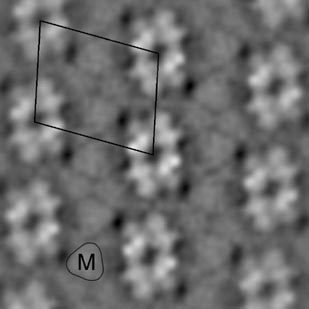Photosystem II
Photosystem II complex from Arabidopsis
The Photosystem II (PS II) complex is the abundant large membrane protein in the stacked parts of the thylakoid membrane of green plant chloroplasts. The complex from green plants consists of about 25 different subunits, of which one half is directly involved in light-harvesting. Over the years we have studied various types of PSII preparations from spinach. One of the main conclusions from this work was that Photosystem II complexes are always heterogeous: there is not just one type of complex with a complete set of all subunits. Instead, the so-called core complex binds variable numbers of light-harvesting complex (or LHCII) subunits. These subunits are partly organized as heterotrimers and partly as monomers. According to the sites where they bind to the PSII core complex, three different types of LHCII trimers exist. We have named them S, M and L (from strong, medium and low) to emphasize their decreasing ability to associate with the dimeric spinach core complex. The most abundant types of spinach PSII complexes consist of dimeric core complexes ("C2") to which two S-type trimers are bound and 0-1 M-type trimers (C2S2 and C2S2M particles, respectively). Particles with an additional M-type trimer (C2S2M2 particles) and additional L-type trimers (such as C2S2L and C2S2ML) are rather rare after mild membrane disruption. This heterogeneity was confirmed by an investigation of natural occurring small patches of two-dimenional crystals. The most common type of crystal consists of C2S2M partcles and a simultaneous occurring uncommon crystal type of C2S2 particles.
We have extended these studies by turning to Arabidopsis (dutch name: "Zandraket"), in collaboration with the group of Dekker from the VU Amsterdam and with Scheller’s group from Denmark). Arabidopsis is the first plant of which the complete genome sequence was recently determined, offering greater upportunities for structural studies, for instance with knock-out mutants. A first systematic characterization of isolated particles from native Arabidopsis indicates that there is a lot more of C2S2M2, in comparison to spinach, but no evidence for the existence of L-type trimers. Natural crystalline patches do also occur in Arabidopsis. Interestingly, they contain a larger particle than the spinach domains; the symmetric C2S2M2 particle (see the figure below).

Thus it appears that Arabidopsis PSII complexes have a stronger affinity for the peripheral M-type LHCII trimers, but it could also be possible that this type LHCII trimer is more abundant in Arabidopsis anyway. The hypothesis of the stronger binding of M-type trimers is confirmed by finding particles that still contain an M-type trimer, but no S-type trimer on the same side of the core complex. The frequency of such complexes in spinach is a factor of 100 times lower.
